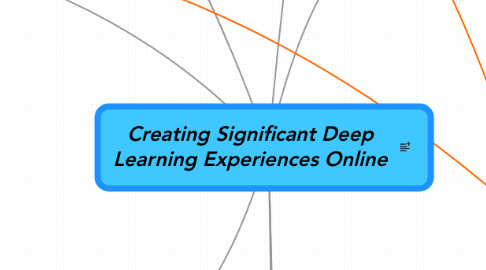
1. 4. Define Deep Learning (CONTINUED)
1.1. Provide some examples:within a course, within a lesson plan, by competency
1.2. e.??? Would a small group activity be a good next step. Maybe they could mee tin groups in Adobe Connect to develop their own defintion of deep learning.
1.3. f. DEBRIEF this series of activities related to deep learning.
2. 2. Define Deep Learning
2.1. Provide some examples:within a course, within a lesson plan, by competency
2.2. WE NEED TO DEVELOP OUR WORKING DEFINITION OF DEEP LEARNING.
2.3. a. REFLECT on what Deep Learning means to YOU. Think of deep learning in different ways and from different perspectives.
2.4. b. BRAINSTORM using THE BLOG Comment Section. display results using Wordle
2.5. c. PROVIDE a review of the literature on deep learning. Relate Deep Learning to Blooms Taxonomy
2.5.1. Marc, can we place the articles we are referring to in Bb, e-reserves, in the Blog? BD
2.5.2. Pull interviews from Nicolet College students and staff related to defining deep learning.
2.6. d. CONCEPT MAP ACTIVITY. Participants develop their own concept maps using Mindmeister and then post them in the blog. Then review and comment on one other concept map.
2.7. e.??? Would a small group activity be a good next step. Maybe they could mee tin groups in Adobe Connect to develop their own defintion of deep learning.
2.8. f. DEBRIEF this series of activities related to deep learning.
3. 1. INTRODUCTION
3.1. a. Workshop Environment
3.2. b. MIND CALM
3.3. c. ICE BREAKER activity. Conduct this virtually, "6 degrees of separation."
3.4. Introduction. Let's get ideas of what other people's experiences are....
3.4.1. I'd like to build on this idea. What do you think about asking participants to write down an instructional challenge that they would like to solve.. We could use some of these in a problem-based activity later in the workshop. We may still want to develop other potential problems to solve. BD
3.5. This will be a mindset tool first - and THEN will be an activity to get people to interact and learn who is there and talk about an example of how this could be done online.
4. 6. Leave with Steps to Deep Learning and Tools To Do So TM
4.1. I like this idea BD
4.2. HIGHER ORDER PROBLEM SOLVING AND INQUIRY. What do you think about providing some situations and asking the participants to apply what they have learned.
4.3. Maybe add a reflection activity where participants think about how applications in other contexts.
5. 3. Walk and Talk break
6. Why should we create deep learning experiences online?
6.1. Brainstorm: What skills are needed to be successful in today's workforce? Are we teaching these skills? How can we = Deep Learning
6.2. Maybe we could ask participants to describe a situation where they want to move the learning from surface to deep.
7. 5. Play around with some tools
7.1. Concept Maps Actvities
7.1.1. Create Branches with Multimedia and additional links to new learning opportunities TM
7.1.2. Require high level thinking but can be difficult to assess. Given this, how best should they be used? Early learning tool? TM
7.1.2.1. In the article by Chang & Chang they used concept maps as an activity along with peer learning. They found that this activity improved performance in concept application.. BD
7.2. Dynamic online discussions.
7.2.1. unthreaded conversations
7.2.2. Anonymous brainstorms within which contributions appear scattered on the page
7.2.3. Debates
7.2.4. Hot seats, allow answers to be inserted directly below the question.
7.3. Create new environments to engage the students synchronously
7.3.1. Windows Live Meeting
7.3.2. Adobe Connect
7.3.3. Will students challenge this given the biggest benefit to online is being able to work on "my time?" TM
7.3.3.1. Good question. I think they will need synchronous space if they are going to work collaboratively or when they want to connect with their instructor or for other support. BD
7.3.4. Use this as a study group???
7.4. Collaborative Virtual Spaces
7.4.1. Weigel calls these knowledge rooms and gave several examples. i wonder if we could create a knowledge room using a wiki. BD
7.4.2. Empower students to create their own web content
7.4.2.1. Blogs
7.5. Digital maps
7.6. Galleries
7.7. Videos
8. Find out more? Try http://www.mindmeister.com/help
9. How do we create the culture of learning? ie - change the environment... Does it need to change?
9.1. How do we get the students to Apply and integrate material? - get to the highest part of blooms taxonomy? Do we need to get there?
9.1.1. Devise their own theories and test and apply them.
9.2. Connect to other classes and students
9.3. Connect to non-college people to apply what they are learning - service learning?
9.4. Smaller Group Discussions?
9.5. Engagement
9.5.1. Options
9.5.2. Pop Culture
9.5.3. Contextualize
9.5.3.1. Personal Life
9.5.3.2. Professional Life
9.5.4. Multimedia
